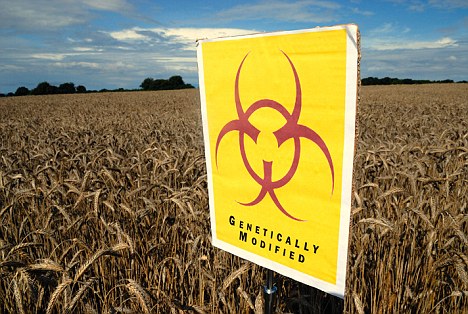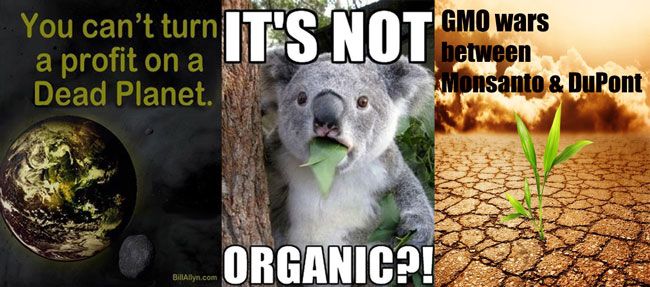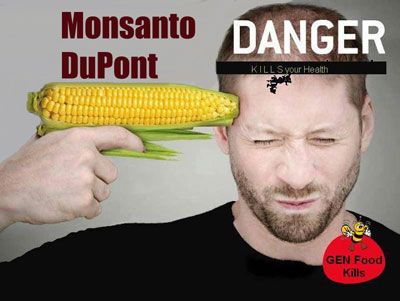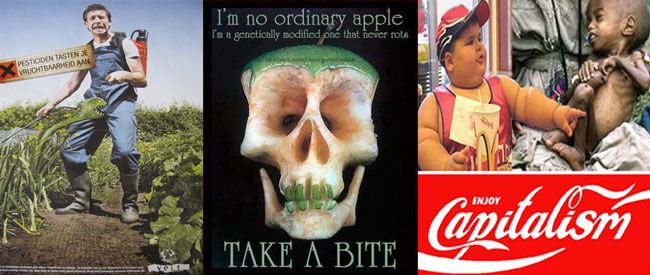The Permaculture Research Institute
 Something doesn’t quite add up about genetically modified (GM) foods.
Something doesn’t quite add up about genetically modified (GM) foods.
It
looks the same—the bread, pies, sodas, even corn on the
cob. So much of what we eat every day looks just like it did 20 years
ago. But something profoundly different has happened without our
knowledge or consent. And according to leading doctors, what we don’t
know may already be hurting us big time.
In May, the American Academy of Environmental Medicine (AAEM)
publicly condemned genetically modified organisms (GMOs) in our food
supply, saying they posed “a serious health risk.” They called on the US
government to implement an immediate moratorium on all genetically
modified (GM) foods, and urged physicians to prescribe non-GMO diets for
all patients.
GM-What?
Genetic engineering is quite distinct from selective breeding because
it involves taking genes from a completely different species and
inserting them into the DNA of a plant or animal. The long term effects
of this for our health and our planet’s biodiversity are unknown.
AAEM, an “Academy of Firsts,” was the first US medical organization
to describe or acknowledge Gulf War Syndrome, chemical sensitivity, food
allergy/addiction, and a host of other medical issues. But the
potential for harm from GMOs dwarfs anything they have identified thus
far. It can impact everyone who eats.
More than 70% of the foods on supermarket shelves contain derivatives
of the eight GM foods on the market—soy, corn, oil from canola and
cottonseed, sugar from sugar beets, Hawaiian papaya, and a small amount
of zucchini and crook neck squash. The biotech industry hopes to
genetically engineer virtually all remaining vegetables, fruits, grains,
and beans (not to mention animals).
The two primary reasons why plants are engineered are to allow them to either
drink poison, or
produce
poison. The poison drinkers are called herbicide tolerant. They’re
inserted with bacterial genes that allow them to survive otherwise
deadly doses of toxic herbicide. Biotech companies sell the seed and
herbicide as a package deal, and US farmers use hundreds of millions of
pounds more herbicide because of these types of GM crops. The poison
producers are called Bt crops. Inserted genes from the soil bacterium
Bacillus Thuringiensis
produce an insect-killing pesticide called Bt-toxin in every cell of
the plant. Both classes of GM crops are linked to dangerous side
effects.
Doctors and Patients: Just Say No to GMOs
“Now that soy is genetically engineered,” warns Ohio allergist Dr.
John Boyles, “it is so dangerous that I tell people never to eat it.”
How dangerous are GM foods? World renowned biologist Pushpa M. Bhargava,
PhD, believes they are the major reason for the recent rise in serious
illnesses in the US.
The range of what GMOs might do to us is breathtaking. “Several
animal studies,” according to the AAEM, reveal a long list of disorders,
including: “infertility, immune dysregulation, accelerated aging,
dysregulation of genes associated with cholesterol synthesis, [faulty]
insulin regulation, cell signaling, and protein formation, and changes
in the liver, kidney, spleen and gastrointestinal system.”
“There is more than a casual association between GM foods and adverse
health effects,” says the AAEM position paper. Based on established
scientific criteria, “there is causation.”
Difficult to Trace the Damage
Outside the carefully controlled laboratory setting, it is more
difficult to confidently assign GMOs as the cause for a particular set
of diseases, especially since there are no human clinical trials and no
agency that even attempts to monitor GMO-related health problems among
the population. “If there are problems,” says biologist David Schubert,
PhD, of the Salk Institute, “we will probably never know because the
cause will not be traceable and many diseases take a very long time to
develop.”
GM crops were widely introduced in 1996. Within nine years, the
incidence of people in the US with three or more chronic diseases nearly
doubled—from 7% to 13%. Visits to the emergency room due to allergies
doubled from 1997 to 2002. And overall food related illnesses doubled
from 1994 to 2001, according to the Centers for Disease Control.
Obesity, diabetes, gastrointestinal disorders, and autism are also among
the conditions that are skyrocketing in the US.
The Lyme Induced Autism Foundation, a patient advocacy group, is not
waiting for studies to prove that GMOs cause or worsen Lyme, autism, and
the many other diseases on the rise since gene-spliced foods were
introduced. Like AAEM, the LIA Foundation says there is more than enough
evidence of harm in animal feeding studies for them to “urge doctors to
prescribe non-GMO diets” and for “individuals, especially those with
autism, Lyme disease, and associated conditions, to avoid” GM foods.
Another patient group, those suffering from eosinophilia myalgia
syndrome (EMS), is more confident about the GMO origins of their
particular disease. It was caused by a genetically engineered brand of a
food supplement called L-tryptophan in the late 1980s. It killed about
100 Americans and caused 5,000-10,000 people to fall sick or become
permanently disabled. The characteristics of EMS made it much easier for
authorities to identify the epidemic and its cause. It only affected
those who consumed the pills; symptoms came on almost immediately; and
its effects were horrific—including unbearable pain and paralysis. There
was even a unique, easy-to-measure change in the white blood cell
count. But even though EMS was practically screaming to be discovered,
it still took the medical community more than four years—and it was
almost missed.
“The experiments simply haven’t been done and we now have become the guinea pigs.” David Suzuki, renowned Canadian geneticist.
What if the GMOs throughout our food supply are creating
common diseases which come on
slowly?
It would be nearly impossible to confirm them as the cause. “Physicians
are probably seeing the effects in their patients,” says AAEM president
Dr. Jennifer Armstrong, “but need to know how to ask the right
questions.” The patients at greatest risk are the very young. “Children
are the most likely to be adversely effected by toxins and other dietary
problems” related to GM foods, says Dr. Schubert. They become “the
experimental animals,” our collective canaries in the coal mine.
Warnings by Government Scientists Ignored and Denied
Scientists at the Food and Drug Administration (FDA) had warned about
all these problems back in the early 1990s. According to secret
documents made public from a lawsuit, the scientific consensus at the
agency was that GM foods were inherently dangerous, and might create
hard-to-detect allergies, poisons, new “super” diseases, and nutritional
problems. They urged their superiors to require rigorous long-term
tests. But the White House had ordered the agency to promote
biotechnology and the FDA responded by recruiting Michael Taylor,
Monsanto’s former attorney, to head up the formation of GMO policy. That
policy, which is in effect today, denies knowledge of the scientists’
concerns and declares that no safety studies on GMOs are required. It is
up to Monsanto and the other biotech companies—who have a long history
of lying about the toxicity of their earlier products—to determine if
their own foods are safe.
After overseeing GMO policy at the FDA, Mr. Taylor worked on GMO
issues at the USDA, and then later became Monsanto’s vice president. In
the summer of 2009, he went through the revolving door again. Taylor was
appointed by the Obama administration as the de facto US food safety
czar at the FDA.
Dangerously Few Studies, Untraceable Diseases
“Where is the scientific evidence showing that GM plants/food are
toxicologically safe, as assumed by the biotechnology companies?” This
was the concluding question posed in a 2007 review of published
scientific literature on the health risks of GM plants, showing that the
number of studies and available data are “very scarce.”
“The experiments simply haven’t been done and we now have become the
guinea pigs,” says renowned Canadian geneticist David Suzuki. He adds,
“Anyone that says, ‘Oh, we know that this is perfectly safe,’ I say is
either unbelievably stupid or deliberately lying.”
When consumers realize the dangers of GM foods and that the FDA has
abdicated its responsibility to protect us, they usually want to opt out
of this massive feeding experiment. In fact, most Americans
already say they would avoid GMO brands if given a choice.
It wouldn’t take a majority of us to kick GMOs out of our food supply. Kraft and other food companies wouldn’t wait until
half
their market share is gone before telling their suppliers to switch to
the non-GM corn, soy, etc. By using GM ingredients, they don’t offer
customers a single advantage. The food doesn’t taste better, last
longer, or have more nutrients. Thus, if even a tiny percentage of US
consumers—say 5% or 15 million people—started avoiding GMO brands, the
millions in lost sales revenue would likely force brands to remove
all GM ingredients, like they already have in Europe.
But the FDA doesn’t want to give us the choice. They ignore the
wishes of nine out of ten Americans for mandatory GMO labeling in order
to promote the economic interests of just five biotech companies.
The Shocking Evidence of Harm from GMOs
Genetically modified (GM) foods have not been scientifically tested
on human beings. (The only published human feeding study had ominous
results – see later.) Instead, animals are used as our surrogates, but
the few published animal safety studies are generally short-term and
superficial. In fact, industry-funded research is widely criticized as
designed
to avoid finding problems. They’ve got bad science—down to a science.
Even still, the accumulated evidence of harm is compelling people to
read ingredient labels and avoid brands with genetically modified
organisms (GMOs).
Infant Mortality and Reproductive Disorders
When GM soy flour was added to the diets of female rats, most of
their babies died within three weeks—compared to only a 10% death rate
among mothers fed natural soy. The babies from the GM-fed group were
also smaller and later had problems getting pregnant.
When male rats were fed GM soy, their testicles actually changed
color—from the normal pink to dark blue. Mice testicles also showed
changes, including damaged young sperm cells. And the DNA in mice
embryos functioned differently when their parents ate GM soy. Mice fed
GM corn had fewer babies, and their children were smaller than normal.
About two dozen US farmers say that thousands of their pigs became
sterile after consuming certain GM corn varieties. Some had false
pregnancies; others gave birth to bags of water. Cows and bulls also
became infertile when fed the same corn. Investigators in the state of
Haryana, India, report that most buffalo that ate GM cottonseed had
reproductive complications such as premature deliveries, abortions,
infertility, and prolapsed uteruses. Many calves died.
In the US population, the incidence of low birth weight babies, infertility, and infant mortality are all escalating.
Food, A Registered Pesticide?
When insects bite genetically modified Bt corn and cotton, they get a
mouthful of a built-in toxin, produced by every cell of the plant. The
poison splits open their stomach and kills them. The GM plants are
registered as pesticides with the Environmental Protection Agency.
Biotech companies claim that Bt-toxin has a history of safe use,
since organic farmers and others use Bt bacteria spray for natural
insect control. Genetic engineers insert genes from the bacteria into
the DNA of the corn and cotton, so the plants themselves do the killing.
They fail to point out that the Bt-toxin produced in GM plants:
- Is thousands of times more concentrated than natural Bt spray;
- Is designed to be more toxic;
- Has properties of an allergen; and
- Unlike the spray, cannot be washed off the plant.
But even the less toxic
natural bacterial spray is harmful.
When dispersed by plane to kill gypsy moths in the Pacific Northwest,
about 500 people reported allergy or flu-like symptoms. Some had to go
to the emergency room.
Those exact same symptoms are now being reported by farm workers
handling Bt cotton grown in India. According to
Sunday India, medical records confirm that “victims of itching have increased massively . . . related to Bt cotton farming.”
If GM Crops Kill Animals, How Safe Are They for Us to Eat?
When sheep grazed on Bt cotton plants after harvest, thousands died.
Post mortems showed severe irritation and black patches in their
intestines and livers. Investigators said preliminary evidence “strongly
suggests that the sheep mortality was due to a toxin. . . . most
probably Bt-toxin.” In a small feeding study, 100% of sheep fed Bt
cotton died within 30 days, while those grazing on natural cotton plants
in the adjoining field had no symptoms.
Similarly, buffalo that grazed on natural cotton plants for years
without incident are reacting to the Bt variety. In one village, for
example, they allowed their 13 buffalo to graze on Bt cotton plants for a
single day in January 2008. All died within three days.
Bt corn was also implicated in the deaths of cows in Germany, and
horses, buffaloes, and chickens in The Philippines. Even Monsanto’s own
90-day rat feeding study showed evidence of poisoning in major organs
due to their Bt corn. And a 2008 Italian government study found that Bt
corn provoked immune responses in mice.
GMOs Contain Allergens
Immune system problems in GMO-fed animals are “a consistent feature
of all the studies,” according to GM food safety expert Dr. Arpad
Pusztai. The American Academy of Environmental Medicine specifically
notes an increase in cytokines, “associated with asthma, allergy, and
inflammation.” While all three conditions are on the rise in the US, it
is the upsurge in food allergies among children that has generated the
most alarm nationwide.
There are many reasons why GMOs might be the cause:
- The GM proteins produced in GM soy, corn, and papayas have
properties of known allergens. They actually fail the allergy screening
protocol recommended by the World Health Organization.
- The process of creating a GMO can introduce new allergens or elevate
existing ones. Both GM soy and corn contain new unintended allergenic
proteins, and GM soy has as much as seven times higher levels of a
natural soy allergen—trypsin inhibitor.
- Herbicide tolerant GM crops have considerably more residues of toxic herbicides, which may provoke reactions.
- Skin prick allergy tests confirm that some people react to GM, but not to non-GM soy.
Soon after GM soy was introduced to the UK, soy allergies skyrocketed
by 50%. But there are other non-GM foods that are also provoking more
allergic responses now than in the past. Research shows, however, that
consuming GM foods may still be the culprit by provoking sensitivity to
other foods.
Mice fed Bt-toxin, for example, not only reacted to the Bt itself,
they started having immune reactions to foods that were formerly
harmless. Similarly, after mice ate GM peas, they started to react to
other foods that previously had no impact. In addition, GM soy
drastically reduces digestive enzymes in mice. If our ability to
breakdown proteins is impaired, we could become allergic to a wide
variety of foods.
GMOs and Liver Problems
As a primary detoxifier, the condition of the liver can point to
toxins in our diet. The livers of mice and rats fed GM feed had profound
changes. Some were smaller and partially atrophied, others were
significantly heavier, possibly inflamed, and some showed signs of a
toxic insult from eating GM food.
The Worst Finding of All? GMOs Remain Inside Us!
The only published human feeding study revealed what many find to be
the most disturbing discovery. The genes inserted into GM crops transfer
into the DNA of bacteria living inside our intestines
and continue to function.
This means that long after we stop eating GMOs, we may still have
potentially harmful GM proteins produced continuously inside of us.
Although scientists only tested this on soy, if Bt genes from corn chips
also transferred, they could transform our intestinal bacteria into
living pesticide factories, possibly for the rest of our lives.
When doctors hear about this evidence, they often respond by citing
the huge increase of gastrointestinal problems over the last decade. GM
foods might be colonizing the gut flora of North Americans.
Even if GMOs helped combat global hunger, which they don’t, it would
be hard to justify putting these high-risk organisms into the food
supply in their current state. Especially since GM crops cross-pollinate
and contaminate the environment. Their self-propagating genetic
pollution may outlast the effects of global warming and nuclear waste.
Shhhh! Meet the Scientists Who Dared to Break the Silence on GMOs
Arpad Pusztai
Biologist Arpad Pusztai had more than 300 articles and 12 books to
his credit and was the world’s top expert in his field. But when he
accidentally discovered that genetically modified (GM) foods are
dangerous, he became the biotech industry’s bad-boy poster child,
setting an example for other scientists thinking about blowing the
whistle.
In the early 1990s, Dr. Pusztai was awarded a $3 million grant by the
UK government to design the system for safety testing genetically
modified organisms (GMOs). His team included more than 20 scientists
working at three facilities, including the Rowett Institute in Aberdeen,
Scotland, the top nutritional research lab in the UK, and his employer
for the previous 35 years. The results of Pusztai’s work were supposed
to become the required testing protocols for all of Europe. But when he
fed supposedly harmless GM potatoes to rats, things didn’t go as
planned.
Within just 10 days, the animals developed potentially pre-cancerous
cell growth, smaller brains, livers, and testicles, partially atrophied
livers, and damaged immune systems. Moreover, the cause was almost
certainly side effects from the
process of genetic engineering
itself. In other words, the GM foods on the market, which are created
from the same process, might have similar affects on humans.
With permission from his Director, Pusztai was interviewed on TV and
expressed his concerns about GM foods. He became a hero at his
Institute—for two days. Then came the phone calls from the pro-GMO Prime
Minister’s office to the Institute’s Director. The next morning,
Pusztai was fired. He was silenced with threats of a lawsuit, his team
was dismantled, and the protocols never implemented. His Institute, the
biotech industry, and the UK government, together launched a smear
campaign to destroy Pusztai’s reputation.
Eventually, an invitation to speak before Parliament lifted his gag order and his research was published in the prestigious
Lancet. No similar in-depth studies have yet tested the GM foods eaten every day by Americans and Canadians.
Irina Ermakova
Irina Ermakova, a senior scientist at the Russian National Academy
of Sciences, was shocked to discover that more than half of the baby
rats in her experiment died within three weeks. She had fed the mothers
GM soy flour purchased at a supermarket. The babies from mothers fed
natural non-GMO soy, however, only suffered a 10% death rate. She
repeated her experiment three times with similar results.
Dr.
Ermakova reported her preliminary findings at a conference in October
2005, asking the scientific community to replicate her study. Instead,
she was attacked and vilified. Her boss told her to stop doing anymore
GM food research. Samples were stolen from her lab, and a paper was even
set fire on her desk. One of her colleagues tried to comfort her by
saying, “Maybe the GM soy will solve the overpopulation problem.”
Of the mostly spurious criticisms leveled at Ermakova, one was
significant enough to raise doubts about the cause of the deaths. She
did not conduct a biochemical analysis of the feed. Without it, we don’t
know if some rogue toxin had contaminated the soy flour. But more
recent events suggest that whatever caused the high infant mortality was
not unique to her one bag of GM flour. In November 2005, the supplier
of rat food to the laboratory where Ermakova worked began using GM soy
in the formulation.
All the rats were now eating it. After two months, Ermakova asked other scientists about the infant mortality rate in
their experiments. It had skyrocketed to over 55%.
It’s been four years since these findings were reported. No one has
yet repeated Ermakova’s study, even though it would cost just a few
thousand dollars.
Andrés Carrasco
Embryologist Andrés Carrasco told a leading Buenos Aires newspaper
about the results of his research into Roundup®, the herbicide sold in
conjunction with Monsanto’s genetically engineered Roundup Ready® crops.
Dr. Carrasco, who works in Argentina’s Ministry of Science, said his
studies of amphibians suggest that the herbicide could cause defects in
the brain, intestines, and hearts of fetuses. Moreover, the amount of
Roundup® used on GM soy fields was as much as 1,500 times greater than
that which created the defects. Tragically, his research had been
inspired by the experience of desperate peasant and indigenous
communities who were suffering from exposure to toxic herbicides used on
the GM soy fields throughout Argentina.
According to an article in
Grain, the biotech industry
“mounted an unprecedented attack on Carrasco, ridiculing his research
and even issuing personal threats.” In addition, four men arrived
unannounced at his laboratory and were extremely aggressive, attempting
to interrogate Carrasco and obtain details of his study. “It was a
violent, disproportionate, dirty reaction,” he said. “I hadn’t even
discovered anything new, only confirmed conclusions that others had
reached.”
Argentina’s Association of Environmental Lawyers filed a petition
calling for a ban on Roundup®, and the Ministry of Defense banned GM soy
from its fields.
Terje Traavik
Prominent virologist Terje Traavik presented preliminary data at a
February 2004 meeting at the UN Biosafety Protocol Conference, showing
that:
- Filipinos living next to a GM cornfield developed serious symptoms while the corn was pollinating;
- Genetic material inserted into GM crops transferred to rat organs after a single meal; and
- Key safety assumptions about genetically engineered viruses were
overturned, calling into question the safety of using these viruses in
vaccines.
The biotech industry mercilessly attacked Dr. Traavik. Their excuse?
He presented unpublished work. But presenting preliminary data at
professional conferences is a long tradition in science, something that
the biotech industry itself relied on in 1999 to try to counter the
evidence that butterflies were endangered by GM corn.
Ironically, three years after attacking Traavik, the same biotech proponents sharply criticized a peer-reviewed publication for
not
citing unpublished data that had been presented at a conference. The
paper shows how the runoff of GM Bt corn into streams can kill the
“caddis fly,” which may seriously upset marine ecosystems. The study set
off a storm of attacks against its author, ecologist Emma
Rosi-Marshall, which
Nature described in a September 2009 article as a “hail of abuse.”
Nothing to Hide?
When Ohio State University plant ecologist Allison Snow discovered
problematic side effects in GM sunflowers, Pioneer Hi-Bred International
and Dow AgroSciences blocked further research by withholding GM seeds
and genes. After Marc Lappé and Britt Bailey found significant
reductions in cancer-fighting isoflavones in Monsanto’s GM soybeans, the
seed seller, Hartz, told them they could no longer provide samples.
Research by a plant geneticist at a leading US university was also
thwarted when two companies refused him GM corn. In fact, almost no
independent studies are conducted that might find problems.
According to
a scathing opinion piece in an August 2009
Scientific American,
“Agritech companies have given themselves veto power over the work of
independent researchers. . . . Only studies that the seed companies have
approved ever see the light of a peer-reviewed journal.”
Restricted access is not limited to the US. When a Japanese scientist
wanted to conduct animal feeding studies on the GM soybeans under
review in Japan, both the government and the bean’s maker DuPont refused
to give him any samples. Hungarian Professor Bela Darvas discovered
that Monsanto’s GM corn hurt endangered species in his country. Monsanto
immediately shut off his supplies.
Dr. Darvas later gave a speech on
his preliminary findings and discovered that a false and incriminating
report about his research was circulating. He traced it to a Monsanto
public relations employee, who claimed it mysteriously appeared on her
desk—so she faxed it out.
Why is Science and Debate Being Silenced?
The attacks on scientists have taken its toll. There appears to be a
de facto ban on scientists asking certain questions and finding certain
results.
New Zealand Parliament member Sue Kedgley told a Royal Commission in
2001: “Personally I have been contacted by telephone and e-mail by a
number of scientists who have serious concerns about aspects of the
research that is taking place . . . and the increasingly close ties that
are developing between science and commerce, but who are convinced that
if they express these fears publicly, … or even if they asked the
awkward and difficult questions, they will be eased out of their
institution.”
University of Minnesota biologist Phil Regal testified before the
same Commission, “I think the people who boost genetic engineering are
going to have to do a
mea culpa and ask for forgiveness, like the
Pope did on the inquisition.” Sue Kedgley has a different idea. She
recommends we “set up human clinical trials using volunteers of genetic
engineering scientists and their families, because I think they are so
convinced of the safety of their products, I’m sure they would very
readily volunteer to become part of a human clinical trial.”
Failing that, are you willing to continue your participation?
~~~~~~
International bestselling author and independent filmmaker Jeffrey M.
Smith is the Executive Director of the Institute for Responsible
Technology and the leading spokesperson on the health dangers of GMOs.
His first book,
Seeds of Deception, is the world’s bestselling book on the subject. His second,
Genetic Roulette:
The Documented Health Risks of Genetically Engineered Foods, identifies 65 risks of GMOs and demonstrates how superficial government approvals are not competent to find
most
of them. Mr. Smith has pioneered the Campaign for Healthier Eating in
America, designed to create the tipping point of consumer rejection
against GMOs and force them out of the food supply.
To find out how to stop eating GMOs, visit:
www.nongmoshoppingguide.com (USA) and
www.truefood.org.au/truefoodguide (Australia)
Videos:
The Future of Food,
The World According to Monsanto



 Something doesn’t quite add up about genetically modified (GM) foods.
Something doesn’t quite add up about genetically modified (GM) foods.










 - Long term toxicity of a Roundup herbicide and a Roundup-tolerant genetically modified maize
- Long term toxicity of a Roundup herbicide and a Roundup-tolerant genetically modified maize







